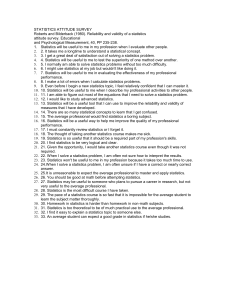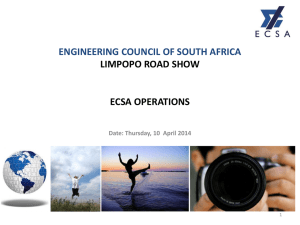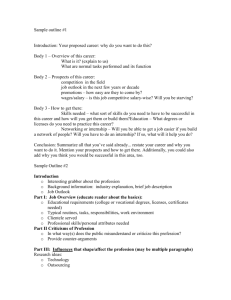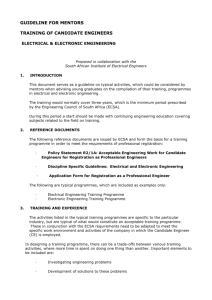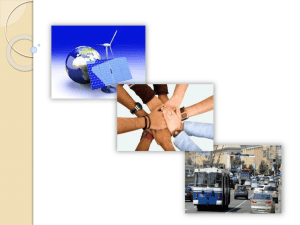IDOEW Policy for CBE 25112013
advertisement
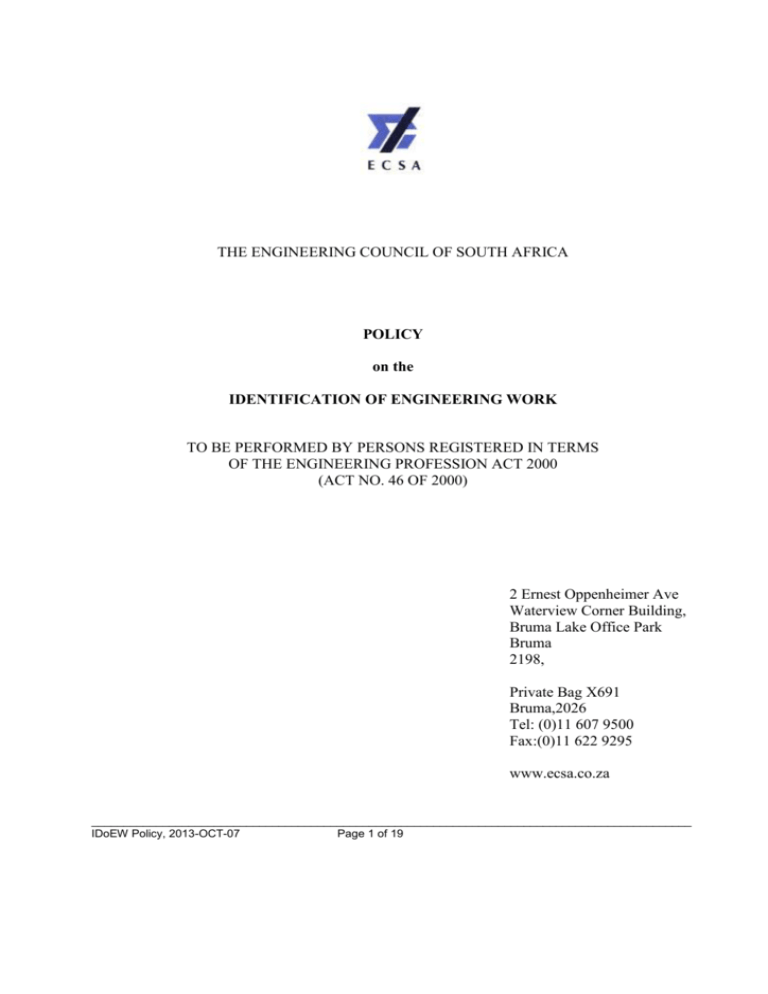
THE ENGINEERING COUNCIL OF SOUTH AFRICA POLICY on the IDENTIFICATION OF ENGINEERING WORK TO BE PERFORMED BY PERSONS REGISTERED IN TERMS OF THE ENGINEERING PROFESSION ACT 2000 (ACT NO. 46 OF 2000) 2 Ernest Oppenheimer Ave Waterview Corner Building, Bruma Lake Office Park Bruma 2198, Private Bag X691 Bruma,2026 Tel: (0)11 607 9500 Fax:(0)11 622 9295 www.ecsa.co.za _____________________________________________________________________________________________ IDoEW Policy, 2013-OCT-07 Page 1 of 19 TABLE OF CONTENTS TOPIC PAGE 1. Preface 4 2. Definitions 5 3. Preamble 6 4. IDoEW Policy purpose and Objectives 7 5. Provisions of the EPA 8 5.1. Registration as Professional Persons or Candidates 8 5.2. Prohibitions and Permissions 8 6. Benefits Accruing from IDoEW 9 7 Framework for establishing IDoEW 10 7.1 The characteristics of IEW 10 7.2 Distinguishing between the different categories of registration 11 7.3 Distinguishing between the different disciplines 11 7.4 Areas of Particular attention in IEW 11 Table 1: Specific types of Engineering Work 15 Table 2: Nature and level of IEW performed by each Category 17 _____________________________________________________________________________________________ IDoEW Policy, 2013-OCT-07 Page 2 of 19 ABBREVIATIONS/ACRONYMS BEPC: Built Environment Professional Council CBE: Council for the Built Environment CPD: Continuing Professional Development ECSA: Engineering Council of South Africa EPA: Engineering Profession Act 46 of 2000 IDOEW: Identification of Engineering Work IEW: Identified Engineering Work _____________________________________________________________________________________________ IDoEW Policy, 2013-OCT-07 Page 3 of 19 1. Preface The Engineering Council of SA (ECSA) is a statutory body established in terms of the Engineering Profession Act 2000, Act 46 of 2000 (EPA). ECSA’s primary role is to regulate the engineering profession in accordance with the requirements of the EPA. ECSA’s core functions relating to the regulation of the engineering profession are as follows: i. ii. Develop internationally benchmarked and recognised standards for the different registration categories; Enter into international agreements for the recognition of educational standards and registration; iii. Visit education providers to evaluate programmes and accredit educational standards that meet the educational requirements toward registration in each of the professional categories; iv. Register persons who meet educational requirements in candidate categories; v. Register persons in professional categories who demonstrate competency against the prescribed standards for the different categories; vi. vii. Establish specified categories of registration to meet health and safety and licencing requirements and register persons in such categories; Require registered persons to renew registration at intervals and under conditions that the Council prescribes; viii. Develop and maintain a code of conduct, supported where necessary by codes of practice; ix. Investigate complaints of improper conduct against registered persons and conduct enquiries and impose sanctions as each case requires; and x. Recommend to the Council for the Built Environment (CBE) ECSA’s identification of the type of engineering work which may be performed by persons registered in any of the categories referred to in section 18, including work which may fall within the _____________________________________________________________________________________________ IDoEW Policy, 2013-OCT-07 Page 4 of 19 scope of any other profession regulated by the professions’ Acts referred to in the CBE Act. ECSA has, in terms of section 26 of the EPA, compiled a framework for the IDoEW. ECSA has consulted widely with interested and affected persons and relevant stakeholders as required in terms of section 26 (2)of the EPA and has proposed IDoEW Regulations in regard to the work identified in terms of subsection (1), for their consideration and identification in terms of section 20 of the CBE Act. 2. Definitions Unless the context indicates otherwise, every word takes the meaning as defined in the EPA and CBEA, and: “categories of registration” means the categories in which a person is registered in terms of section 18 (1)(a) of the Engineering Profession Act; “construction works” means everything that is constructed or results from construction operations; “core service” means a service referred to in item 4 of the IDOEW regulations “ discipline” means the demarcation of the specific body of knowledge within a profession which is applied in a specific context; “ECSA” means the Engineering Council of South Africa established under section 2 of the Engineering Profession Act; “engineering discipline” means the body of knowledge which is applied in one of the following contexts: a. aeronautical; b. agricultural; c. chemical; d. civil; e. electrical; f. industrial; g. mechanical; h. metallurgical; and i. mining; _____________________________________________________________________________________________ IDoEW Policy, 2013-OCT-07 Page 5 of 19 “Engineering Profession Act” means the Engineering Profession Act, 2000 (Act No. 46 of 2000) and any regulations issued in terms thereof; “engineering work” means the process of applying engineering and scientific principles to the research, planning, design and management of both natural and built environments; “profession” means any of the professions regulated by the their respective Acts, “professional certificated engineer” means a person registered in that category in terms of section 18 (1)(a)(iii) of the Engineering Profession Act; “professional engineer” means a person registered in that category in terms of section 18 (1)(a)(i) of the Engineering Profession Act; “professional engineering technician” means a person registered in that category in terms of section 18 (1)(a)(iv) of the Engineering Profession Act; “professional engineering technologist” means a person registered in that category in terms of section 18(1)(a)(ii) (this is correct way of reference) of the Engineering Profession Act; “registered lift inspector” means a person registered in terms of section 18 (1)(c) of the Engineering Profession Act; “registered lifting machinery inspector” means a person registered in terms of section 18 (1)(c) of the Engineering Profession Act; “service” means a core service or a specialised service; “specialised service” means a service which falls outside the standard competencies of a registered person who is a professional and which require an additional qualification, experience, skill and/or registration with any other applicable council for the professions. 3. Preamble WHEREAS section 24 of the Constitution of the Republic of South Africa grants everyone the right to an environment that is not harmful to their health or well-being and to have the environment protected, for the benefit of present and future generations, through reasonable legislative and other measures; AND WHEREAS section 22 of the Constitution grants every citizen the right to choose a trade, occupation or profession, provided that such practice of trade, occupation or profession may be regulated by law; _____________________________________________________________________________________________ IDoEW Policy, 2013-OCT-07 Page 6 of 19 AND WHEREAS sections 14 (g) through (k) of the EPA empowers the ECSA where, as a result of engineering-related undertakings, public health and safety may be affected, to take any steps it considers necessary: (a) for the protection of the health and safety of the public in their dealings with registered persons; (b) for the maintenance of the integrity and the enhancement of the status of the engineering profession; (c) for the improvement of the standards of services rendered by registered persons; and (d) to create an awareness amongst registered persons of the importance to protect the environment against unsound or inappropriate engineering practice. AND WHEREAS the Council for the Built Environment (CBE) in terms Section 22 (2) of the Council for the Built Environment Act (CBEA), read with regulations 2 of the Identification of Work Regulations, 2013, and in accordance with the Policy with Regard to the Identification of Work for the Built Environment Professions, determined by the CBE under Section 20 (1)(a) of the CBEA, may identify the scope of engineering work to be reserved for registered engineering practitioners; AND WHEREAS section 18 (1) of the EPA empowers ECSA to register persons in the engineering profession in certain categories; AND WHEREAS ECSA has, in terms of section 26 (1) of the EPA consulted widely with voluntary associations, persons, bodies and industries that may be affected by any laws regulating the built environment professions regarding the identification of the type of engineering work which may be performed by persons registered in any categories provided for in the Act, including work which may fall into the scope of any other profession regulated by that professions’ act referred to in the CBE Act; AND WHEREAS section 26(2) of the EPA requires the Council to make recommendations to the CBE regarding the engineering work identified in terms of Section 26 (1) which prohibits any person not registered in the appropriate category in terms of the EPA, from performing such Identified Engineering Work (IEW); AND WHEREAS the engineering profession is regarded as an occupation in which an individual uses an intellectual skill based on an established body of knowledge and practice to provide a specialised service in a defined area in the public interest, exercising independent judgment in accordance with a code of ethics. AND WHEREAS a profession is regulated to assure the quality of professional services in the public interest by: setting standards of professional qualifications and practice; keeping a Register of competent persons and allowing the use of associated titles; prescribing a Code of Professional Conduct for Registered Persons; investigating complaints of unpro_____________________________________________________________________________________________ IDoEW Policy, 2013-OCT-07 Page 7 of 19 fessional conduct; and imposing disciplinary sanctions in the case of proven misconduct by a Registered Person. AND WHEREAS Registered Persons in various disciplines of engineering practise in technical, managerial, operational, project-specific, educational and consultancy environments which are unique and multi-disciplinary; work with investors and other clients in the private sector and with clients in the public sector, as salaried employees, under contractual arrangements or as consultants or agents; subject to the requirements of various statutes and regulations; in a wide variety of site conditions; are responsible for investigations, materials, equipment technologies, design, construction and installation, commissioning, operations, maintenance and repair of installations and infrastructure, and providing technical advice; AND WHEREAS Registered Persons are registered in specific categories in accordance with the requirements of the EPA, ECSA must recommend to the CBE its Policy for IDOEW which must be reserved for Registered Persons in the different categories and who have the requisite competence in any of the recognized engineering categories and disciplines. 4. Purpose and objectives of the IDoEW Policy The purpose and objectives of ECSA’s POLICY for the Identification of Engineering Work (IDoEW) includes but is not limited to: i. ii. iii. iv. v. vi. vii. comply with legislative requirements; protect the health and safety of the public by defining the engineering work that must be undertaken only by competent persons in each registration category and in a recognized engineering discipline of the Engineering Profession; protect the natural environment; provide for the IDoEW and the demarcation of work between categories of registration and engineering disciplines in the Engineering Profession, provide an effective and efficient mechanism for regulating the carrying out of work which occurs in areas of overlap between and duplication in the work identified as being reserved for Registered Persons in the different built environment professions; ensure that there are clear and transparent ways for determining which identified work in engineering may be performed by Registered Persons in different categories of registration or in different engineering disciplines; ensure the transparency of and accountability for the process of identification of work in engineering, and _____________________________________________________________________________________________ IDoEW Policy, 2013-OCT-07 Page 8 of 19 viii. achieve the economically, socially and technically most appropriate and efficient use of the various categories of registration in the built environment professions in South Africa with a view to attaining maximum benefit for the public. 5. Provisions of the EPA 5.1 Registration as Professional Persons or as Candidates The EPA empowers ECSA to consider and decide on applications from individuals for registration in one or more of the categories of Registered Person in engineering, prescribe the period of validity of registration of a Registered Person, and keep a register of Registered Persons. In so doing ECSA must determine competency standards for the purposes of registration, and the nature and extent of Continuing Professional Development (CPD) required for renewal of registration after expiration of the validity period. ECSA may take any other steps it considers necessary for the protection of the public and the environment in relation to the activities of Registered Persons, and for the maintenance of the integrity and the enhancement of the status of the engineering profession. The EPA provides for the registration of persons in four professional categories, namely, professional engineer, professional engineering technologist, professional certificated engineer, professional engineering technician, as well as candidates in each of these categories. The Council may from time to time determine the need for registration in Specified Categories, inclusive of registered lift inspectors. Non-registered persons are prohibited from practising within a category without being registered in that category. The EPA prescribes that, in order for an applicant to be registered by the Council, the Council must be satisfied that: (a) applicants for registration as a professional must satisfy the relevant educational outcomes and have demonstrated his or her competence as measured against standards determined by the Council for the relevant category of registration, and has passed any additional examinations that may be determined by the Council; and (b) applications for registration as a candidate must have satisfied the relevant educational outcomes determined for this purpose by the Council. The Council is required to draw up a Code of Conduct for registered persons, may draw up a Code of Practice, and is responsible for administering such codes and investigate breaches of these codes as improper conduct. _____________________________________________________________________________________________ IDoEW Policy, 2013-OCT-07 Page 9 of 19 5.2 Prohibitions and Permissions Sections 18 (2) and 18 (3) of the EPA: i. Prohibit a person who is not registered in a category from practicing in that category of registration; and ii. Permit a person registered in a category to consult in that category. Section 18 (4) (c) of the EPA further requires that a candidate in a category may perform work in the engineering profession but only under the supervision and control of a Registered Person in that category. Consequently a candidate may not provide a consulting service as an individual. Section 26 (3) of the EPA prohibits a person who is not registered in terms of the EPA from per-forming any kind of work identified for any category of Registered Persons. Section 26 (4), however, allows an unregistered person to do such work under the supervision and control of a Registered Person who must take the responsibility for the work. Accordingly, a Registered Person taking responsibility for the work of unregistered persons must do so from a fully informed position, must exercise active supervision and control and must approve all critical decisions. It would be unethical for the Registered Person simply to accept a recommendation from the unregistered person. 6. Benefits accruing from the IDoEW The following are some of the approaches for regulating a profession adopted elsewhere in the world: (a) Licensing: Licensing can take the form of statutory or non-statutory licensing. An area of work restricted by statutory licensing may not be undertaken by an unlicensed person. Non-statutory licensing is imposed by consent between peers and the public is provided with lists of persons who are considered by their peers to be competent to undertake the work in question but this work can also be undertaken by non-licensed persons, i.e. persons not on the list. (b) Registration: Regulation of a profession implies the setting of standards, the keeping of a register of competent persons who meet the standards, and the award of titles. Regulation may be statutory, i.e. in terms of an Act of Parliament, or non-statutory where the regulations are set voluntarily by the elected governing body of the profession. In a non-statutory registration system, governing bodies can resort only to civil _____________________________________________________________________________________________ IDoEW Policy, 2013-OCT-07 Page 10 of 19 action to prevent non-registered persons from using the title and cannot restrict any area of work to non-registered persons. Statutory regulation implies a statutory register and the protection of title by law and sometimes, but not always, the statutory reservation of an area of work for Registered Persons. In such circumstances it would be an offence, subject to a sanction imposed by a Court, to carry out work in the area without being on the register. Reservation of an area of work in a system of statutory regulation has the same effect as statutory licensing which seeks to restrict an area of work to those who are approved persons. The means of recourse and consequences are, however, very different. (c) Specialist Lists: The non-statutory voluntary listing of professionals who comply with a defined standard of competence in a specialist area, typically administered by a professional or trade body, constitutes a Specialist List. In essence, licensing authorises eligible persons to practise in a specific area, registration recognizes demonstrated achievement of a defined standard of competency, while specialist lists indicate peer-recognized competence in a particular area. With full implementation of the EPA, statutory regulation of the practice of engineering in South Africa implies activation of the mechanisms described in paragraph (b) above, namely statutory registration and the prohibition of performance of identified work by persons who are not registered. The regulation of a profession in any form is to some extent restrictive. However, the main purpose in South Africa is to ensure that professional functions are performed only by persons with the necessary competence, in a manner that is consistent with government’s competition policy, and which protects the health and safety of the public, protects the natural environment and provides recourse in cases of unprofessional conduct. The CBE’s Framework for the identification of work, seeks to demarcate functions in the profes-sions and professional categories of registration .It utilizes competencies as a single basis for defi-ning minimum entry standards to the profession, and to address overlaps and duplications between the professions in the built environment. ECSA’s customization of the CBE Framework for the engineering profession is directed by this Policy on the identification of work and is codified in the Draft Regulations attached hereto. 7 Framework for establishing IDOEW 7.1 The characteristics of IEW _____________________________________________________________________________________________ IDoEW Policy, 2013-OCT-07 Page 11 of 19 Identified Engineering Work (IEW) has the following five distinctive characteristics: Characteristic 1: It encompasses specific types of engineering work, activities or services that are listed in column 1 of Table 1. Characteristic 2: It includes one or more of the following activities and, as a consequence, has associated benefits and risks: (a) (b) (c) (d) (e) (f) exploitation of natural resources; harnessing of energy for useful purposes; use of materials and substances to meet a specific need; use of machinery and equipment; transfer, storage and processing of information; construction, maintenance, refurbishment and demolition or decommissioning of buildings, industrial plant and equipment, and physical infrastructure; and (g) organization and control of systems or processes. Because of the risks involved in the above activities, work must be performed without compromising safety, health and environmental standards and taking sustainable development imperatives into account. Characteristic 3: It involves one or more of the generic engineering functions listed in column 2 of Table 1. Characteristic 4: Engineering work can be readily categorized according to (a) the nature of the activities being performed, (b) the level of problem solving required, (c) the level and extent of underpinning knowledge necessary to do the work, and (d) the scope of responsibility accepted by the person doing the work. These criteria for categorization of engineering work are listed in column 3 of Table 1 and in Table 2 where it is illustrated how these four descriptors of the level of the IEW relate to the categories of professional registration defined in the EPA, namely Professional Engineer, Professional Engineering Technologist, Professional Certificated Engineer and Professional Engineering Technician, and the specified categories identified from time to time by ECSA. _____________________________________________________________________________________________ IDoEW Policy, 2013-OCT-07 Page 12 of 19 Characteristic 5: Specific competencies, listed in column 3 of Table 1, are required in order to perform work reserved for a particular category of registration as a Professional Person. These competencies can be acquired in various ways, usually through gaining the requisite engineering knowledge, complemented by the appropriate breadth and depth of experience while in practice under the supervision and guidance of another Registered Person. The nature of engineering work changes continuously, as a consequence for example of new advances in knowledge and technology being made, and as scientific and engineering innovation expand the bounds of viable solutions to the needs of society. Registered Persons are therefore expected to continually maintain and extend their personal level of competency through CPD. 7.2 Distinguishing between the different categories of registration Differentiation between the work reserved for the persons registered in each of the four Profes-sional Categories should reflect the nature of these activities and the requisite level of problem solving described in generic characteristic 4 and the competencies referred to in characteristic 5 above. This differentiation between categories of registration is as follows: i. ii. iii. iv. v. Complex activities and problem solving to be reserved for Professional Engineers; Broadly-defined activities and problem solving to be reserved for Professional Engineering Technologists; Broadly-defined activities and problem solving, where specific legal provisions of other legislation are also present, to be reserved for Professional Certificated Engineers; Well-defined, activities and problem solving to be reserved for Professional Engineering Technicians; and Specifically-defined activities and problem solving to be reserved for Specified Categories. Guidelines clarifying the terms complex, broadly-defined, well-defined and specificallydefined as contemplated in this item must be provided in the regulations 7.3 Distinguishing between the different disciplines IEW as it pertains to the recognized engineering disciplines or sub-disciplines should be IEW as it applies to the discipline-specific context and typical discipline-specific practice areas. 7.4 Areas for particular attention in IEW _____________________________________________________________________________________________ IDoEW Policy, 2013-OCT-07 Page 13 of 19 The following areas must be given explicit attention in the IEW reserved for Registered Persons: i. Academic staff teaching in Engineering Programmes: Academic staff responsible for developing courses, teaching and assessment of students at the exit level in engineering courses leading to an engineering academic qualification must be Registered Persons. ii. Engineering Consultants: Persons in private consulting practice who perform IEW and who take responsibility for the work, activity or service must be Registered Persons; iii. Persons in Public Service: Persons in the employ of all spheres of Government, of State Owned Enterprises and any government entity who perform IEW and take responsibility for such work, activity or service must be Registered Persons iv. Performing IEW across registration categories: Provision must be made for Registered Persons in one category to carry out IEW reserved for another category provided that the person has the requisite competency; v. Performing IEW across recognized disciplines in engineering: Provision must be made for Registered Persons in one engineering discipline to carry out IEW reserved for Registered Persons in another discipline provided that the person has the requisite competence; and vi. Performing work identified as being reserved for Registered Persons in another Built Environment Profession: There are unavoidable overlaps between Built Environment Professions in respect of the work reserved for by Registered Persons in those professions. A person registered in a category provided for by a Built Environment Professional Council (BEPC) may perform the scope of work reserved for persons registered in the appropriate category(ies) with another BEPC if the education, training and experience of that person have specifically rendered him/her competent to perform that work and the work is permitted within the framework of the said reserved work. Accordingly, quality will be assured and the public interests will be protected should professionals who are registered by any of the six Built Environment Profession Councils be _____________________________________________________________________________________________ IDoEW Policy, 2013-OCT-07 Page 14 of 19 permitted to perform any functions in the areas of overlap which their education, training and experience deem them competent to perform. _____________________________________________________________________________________________ IDoEW Policy, 2013-OCT-07 Page 15 of 19 Table 1: Criteria for Identifying Engineering Work for persons Registered with ECSA • • • • • • • • 1 2 3 Specific Types of Engineering Work Generic Functions Performed Abilities / Competencies Transportation systems including roads, railways, waterways, ports, harbours, airports, gas transmission and distribution systems, pipelines, and all associated works such as yards, docks, lighthouses, rolling stock, vessels, aircraft, lifts, hoists and escalators, pumping plant and traffic engineering. Civil works including township services, water treatment and supply, sewerage works, sanitation, soil conservation works, irrigation works, stormwater and drainage works, coastal engineering and solid waste disposal. Structural works relating to the structural safety and serviceability of both the temporary and permanent works associated with structures that provide shelter, carry loads or retain materials or fluids. Mechanical systems including materials handling, lifting machinery heating, ventilation and cooling, prime movers, pumps, internal combustion engines, hydraulic, compressed air and other motive power machinery, agricultural machinery and accessories. Works for the harnessing of energy including that derived from fossil fuel combustion, nuclear fission or fusion and solar radiation and other renewable sources, yielding energy suitable for commercial application. •design of materials, components, systems, plant or processes; •planning the capacity and location of infrastructure. •investigating, advising, costing and reporting on engineering problems; •improvement or optimization of materials, components, systems or processes; •management of, procurement within or the implementation of engineering projects and maintenance of engineering infrastructure; •implementation of engineering designs and solutions; •research, development and commercialization of projects and products; •management of the risk associated with engineering processes, systems, equipment, plant , and infrastructure; •effective communication with a wide range of stakeholders; and •the education, training and mentoring of engineering personnel, including Candidates and students at higher education institutions in programmes that have been accredited by ECSA. Group A: Engineering Problem Solving 1: Define, investigate and analyse engineering problems 2: Design or develop solutions to engineering problems 3: Comprehend and apply knowledge: principles, specialist knowledge, jurisdictional and local knowledge Group B: Management of Engineering Activities 4: Manage part or all of one or more engineering activities 5: Communicate clearly with others in the course of his or her engineering activities Group C: Impacts of Engineering Activity 6: Recognize and address the reasonably foreseeable social, cultural and environmental effects of engineering activities 7: Meet all legal and regulatory requirements and protect the health and safety of persons in the course of his or her engineering activities 8: Conduct engineering activities ethically Electrical power systems for the generation, transmission and distribution of electrical energy and the application thereof. Group D: Exercise judgement, take responsibility 9: Exercise sound judgment in the course of engineering activities 10: Be responsible for making decisions on part or all of engineering activities Electronic systems including that employed in telecommunication, measurement, control and computation. Group E: IPD 11: Undertake initial professional development activities Process systems including chemical works, metallurgical works, manufacturing, food processing such as that in concentrator machinery and apparatus, oil and gas wells, smelters, cyanide plants, acid plants, metallurgical machinery, equipment and apparatus, and _____________________________________________________________________________________________ IDoEW Policy, 2013-OCT-07 Page 16 of 19 works necessary for the beneficiation of metals, minerals, rocks, petroleum and organic substances or other chemical processes. • • Mining operations or activities for the purposes of winning any mineral on, in or under the earth, water or any residue deposit, whether by underground or open working or otherwise. The mechanical, electrical, chemical, electrochemical, metallurgical or heat treatment of any substance, whether organic or inorganic, and combinations thereof for any purpose. •Overseeing the planning, design and delivery of programmes accredited by ECSA at the exit level. •The mentoring of persons in their preparation for registration with ECSA. • • Building services such as water supply, drainage, fire protection measures, electrical and electronic systems Lightning protection _____________________________________________________________________________________________ IDoEW Policy, 2013-OCT-07 Page 17 of 19 Table 2: Nature and level of IEW performed by each Category To be read in conjunction with column 3 of Table 1. Professional Engi- complex engineering work is characterized by: neers (a) Scope of activities may encompass entire complex engineering systems or complex subsystems; (b) A context that is complex and varying, is multidisciplinary, requires teamwork, unpredictable, may need to be identified; (c) Requires diverse and significant resources: including people, money, equipment, materials, technologies; (d) Significant interactions exist between wide- ranging or conflicting technical, engineering or other issues; (e) Are constrained by time, finance, infrastructure, resources, facilities, standards & codes, applicable laws; and (f) Have significant risks and consequences in a range of contexts. Professional Engi- broadly-defined engineering work is characterized by: neering Technolo(a) Scope of practice area is linked to technologies used and changes by adoption of new technologist (b) (c) (d) (e) (f) gy into current practice; Practice area is located within a wider, complex context, requires teamwork, has interfaces to other parties and disciplines; Involve the use a variety resources (including people, money, equipment, materials, technologies); Require resolution of occasional problems arising from interactions between wide-ranging or conflicting technical, engineering or other issues; Are constrained by available technology, time, finance, infrastructure, resources, facilities, standards and codes, applicable laws; and Have significant risks and consequences in practice area and in related areas. Professional Certif- broadly- defined engineering work with some specific legal aspects is characterized by the appliicated Engineer cation of current engineering technology and the management of moderate to high levels of risk, and proficiency in specific contexts linked to government certificates of competence in factories, installations generating, converting, transmitting and consuming all forms of energy, mines and works and on ships. Professional En- well-defined engineering work is characterized by: gineering Techni(a) Scope of practice area is defined by techniques applied; change by adopting new cian techniques into current practice; (b) Practice area is located within a wider, complex context, with well defined working relationships with other parties and disciplines; (c) Work involves familiar, defined range of resources (including people, money, equipment, materials, technologies); (d) Require resolution of interactions manifested between specific technical factors with limited impact on wider issues; (e) Are constrained by operational context, defined workpackage, time, finance, infrastructure, resources, facilities, standards and codes, applicable laws; and (f) Have risks and consequences that are locally important but are not generally far reaching; _____________________________________________________________________________________________ IDoEW Policy, 2013-OCT-07 Page 18 of 19 Specified Categories activities associated with the performance of tasks specified by ECSA. e.g. Lift inspectors – the management of risks associated with lifts, escalators and passenger conveyors. _____________________________________________________________________________________________ IDoEW Policy, 2013-OCT-07 Page 19 of 19
